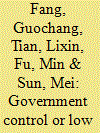| Srl | Item |
| 1 |
ID:
133247


|
|
|
|
|
| Publication |
2014.
|
| Summary/Abstract |
This paper explores a novel selective-constrained energy-saving and emission-reduction (ESER) dynamic evolution system, analyzing the impact of cost of conserved energy (CCE), government control, low carbon lifestyle and investment in new technology of ESER on energy intensity and economic growth. Based on artificial neural network, the quantitative coefficients of the actual system are identified. Taking the real situation in China for instance, an empirical study is undertaken by adjusting the parameters of the actual system. The dynamic evolution behavior of energy intensity and economic growth in reality are observed, with the results in perfect agreement with actual situation. The research shows that the introduction of CCE into ESER system will have certain restrictive effect on energy intensity in the earlier period. However, with the further development of the actual system, carbon emissions could be better controlled and energy intensity would decline. In the long run, the impacts of CCE on economic growth are positive. Government control and low carbon lifestyle play a decisive role in controlling ESER system and declining energy intensity. But the influence of government control on economic growth should be considered at the same time and the controlling effect of low carbon lifestyle on energy intensity should be strengthened gradually, while the investment in new technology of ESER can be neglected. Two different cases of ESER are proposed after a comprehensive analysis. The relations between variables and constraint conditions in the ESER system are harmonized remarkably. A better solution to carry out ESER is put forward at last, with numerical simulations being carried out to demonstrate the results.
|
|
|
|
|
|
|
|
|
|
|
|
|
|
|
|
| 2 |
ID:
128407


|
|
|
|
|
| Publication |
2014.
|
| Summary/Abstract |
With an increase in China's oil imports, China's oil supply will also continue to be effected by the socio-economic stability of oil-exporting countries and the safety of oil transport routes. This paper introduces a systematic and quantitative method to evaluate the influence of China's oil import risks (OIR) on the national economy and industrial sectors from a perspective of apply chain process. For this analysis, China's OIR is quantified by integrating oil exporting country risk and the risks from oil transportation routes. Country risk is defined as the oil-exporting country's political risk caused by political changes or internal conflicts. Transport risk is defined as the risk of shipping routes affected by pirate attacks and geopolitics. Second, the relationship between China's OIR and oil import costs is analyzed using a multiple linear approach. Third, an input-output analysis method is used to research the effect of the cost of China's oil imports on the cost of investment within China's domestic sectors. This research finds that the corresponding impact on GDP is 3494.5 million dollars given an increasing by 10% of China's OIR. And the impact on domestic sectors differs from sector to sector. Finally, this paper puts forth recommendations to improve long-term oil supply security in China.
|
|
|
|
|
|
|
|
|
|
|
|
|
|
|
|